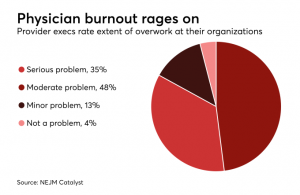By: Saurabh Mathur
Published: July 24, 2019 , 5:30pm EDT
Have you ever shopped online and then later saw ads for the same product on a completely different site? You’re reading a news article or visiting Facebook, and boom, there are those running shoes you were just looking at 15 minutes, or a day ago.
Sound familiar? Or what about when your Alexa, or another virtual assistant, recommends a purchase based on something you added to a shopping list. Helpful? Yes. Unsettling? Yes. Powerful? Also, yes.
These proactive cross-sell marketing techniques are a key to consumer satisfaction, learning from stuff that the consumers are interested in and leading them towards buying similar or related items. The concept behind them—contextual awareness of who we are, where we are, who we are connected to, and what systems we use or have access to—can also help providers improve health outcomes, reduce physician burnout and help U.S. healthcare eliminate billions of dollars of waste every year.
Instead of trying to sell stuff, the idea behind contextual targeting—combining details about the care provider, the patient being treated and content from multiple systems—can be used to deliver relevant information within providers’ current workflow to drive efficiency and help them make preventive and informed decisions to improve health outcomes.
The concept can deliver important aggregated recommended clinical interventions to providers when and where they need it, instead of making them scour for it across various portals and systems, and risk them not finding what is needed or not searching at all. Instead, automated workflows can be triggered at the point of care to give providers deeper, meaningful context, which makes care more proactive, delivery efficient and effective.
You’re probably quite aware that physicians generally hate electronic health records (EHRs). No physicians dispute the necessity of digitizing paper medical charts, but instead of making them more efficient and productive, EHRs have seemingly added to their administrative and data management burdens and fragmented their patient care processes.
With an average health system internally sharing 16 different EHR systems, platforms are often incompatible and require too many clicks, which slows physicians down and distracts them from the patient. Physicians must also continuously access multiple other applications or web portals outside the EHR to connect the different disconnected dots while making decisions for their patients’ health outcomes. They either can’t find what they need or are inundated with a tsunami of irrelevant data that only creates confusion and irritation. The data is deemed irrelevant or is accidentally ignored when lacking context, especially when the patient is long gone after their most recent visit.
All this repetitive searching for information and scanning through meaningless data is costing taxpayers, employers and health insurance policyholders, too. Either through physicians wasting time searching for data or repeating the same tests because they can’t find previous results are all contributing to the more than $1 trillion in wasted healthcare spending each year.
Instead of putting information that providers need in front of them, when and where they need it, the health IT industry ended up creating more applications that generated more data. That data is useful, but often very hard to find or interpret without context.
This brings us back to targeted web ads. Providers know what they need to know about a patient. Since patients often visit other facilities or are attributed to accountable care organizations or multiple health plans, physicians also know there is information available about the patient in systems external to the EHR. Rather than making providers search, the actionable information should be surfaced to them in relevance to the patient’s chart.
For example: if the patient has type 2 diabetes and hypertension, such need-to-know-in-the-moment information might be:
The patient’s most recent HbA1c test is past due
- If their HbA1c results are improving or getting worse
- If they have not refilled a prescription
- If they are behind on their eye or foot exam
- If a referred appointment with a specialist was canceled or skipped and never rescheduled
- If a Health Risk Assessment (HRA) is due for the patient for an eye exam
- If there are Hierarchical Condition Category (HCC) coding gaps in the prior claim submissions
Those important data points, which guide the physician’s decision making and the patient discussion, could be in five different locations or more, all with their own log-in, searching and clicking. Meanwhile, minutes tick away, and physicians and patients grow more frustrated.
Contextually aware software wouldn’t just deliver alerts in a care provider’s workflow; providers already have alert fatigue. This would be made available as a minimally invasive ribbon on a provider’s desktop, resting alongside the patient chart and pairing information from the physician’s own EHR with contextually relevant information from many other places inside and outside the health system, such as (but not limited to):


